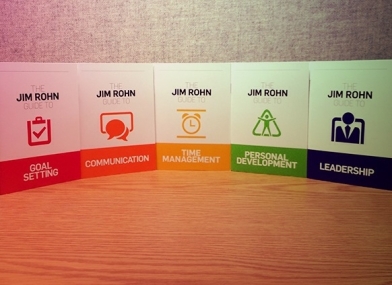Monthly Archives: July 2014
Rohn: 4 Things You Can Learn from Your Child

Remember the master teacher once said 2,000 years ago, “Unless you can become like little children, your chances are zero; you haven’t got a prayer.” This is a major consideration for adults.
Be like children, and remember there are four ways to be more like a child no matter how old you get…
1. Curiosity
Be curious; embrace childish curiosity. What will kids do if they want to know something bad enough? You’re right. They will bug you. Kids can ask a million questions. You think they’re through, then they’ve got another million. They will keep plaguing you. They can drive you right to the brink.
Kids use their curiosity to learn. Have you ever noticed that while adults are stepping on ants, children are studying them? A child’s curiosity is what helps them to reach, learn and grow.
2. Excitement
Learn to get excited like a child. There is nothing that has more magic than childish excitement. So excited that you hate to go to bed at night… that you can’t wait to get up in the morning… that you’re about to explode. How can anyone resist that kind of childish magic?
Now, once in a while I meet someone who says, “Well, I’m a little too mature for all that childish excitement.” Isn’t that pitiful? You’ve got to weep for these kinds of people. All I’ve got to say is, “If you’re too old to get excited, you’re old.” Don’t get that old.
3. Faith
Faith is childish. How else would you describe it? Some people say, “Let’s be adult about it.” Oh, no. No. Adults too often have a tendency to be overly skeptical. Some adults even have a tendency to be cynical.
Adults say, “Yeah. I’ve heard that old positive line before. It will be a long day in June before I fall for that positive line. You’ve got to prove to me it’s any good.” See, that’s adult, but kids aren’t that way.
Kids think you can get anything. They are really funny. You tell them, “We’re going to have three swimming pools.” And they say, “Yeah. Three. One each. Stay out of my swimming pool.” See, they start dividing them up right away, but adults are not like that. Adults say, “Three swimming pools? You’re out of your mind. Most people don’t even have one swimming pool. You’ll be lucky to get a tub in the backyard.”
You notice the difference? No wonder the master teacher said, “Unless you can become like little children, your chances, they’re skinny.”
4. Trust
Trust is a childish virtue, but it has great merit. Have you heard the expression “Sleep like a baby”? That’s it. Childish trust. After you’ve gotten an A+ for the day, leave it in somebody else’s hands.
Curiosity, excitement, faith and trust. That is a powerful combination to bring (back) into our lives.
– See more at: http://www.success.com
5 Life Lessons You Never Learned in School

“Learn to work harder on yourself than you do on your job,” the late philosopher says with his unique cadence and tone.
But listen to the words from Rohn’s mouth and you know that this man’s advice is anything but contradictory. He’s not saying you shouldn’t work hard at a job you love. The hard work comes naturally when you love what you do. What Rohn is saying is that personal development—the building and strengthening of you—is how you become better at everything else. Communication, time management, goal setting, leadership—these all improve when you do.
SUCCESS has compiled a series of five guides on communication, time management, goal setting, leadership and personal development, based on the transcripts of Rohn’s most popular lectures and writings. Released this month in the SUCCESS Store, The Jim Rohn Guide Series comprises curated, 20-minute infusions of wisdom you’ll not likely find elsewhere.
Here we share the SUCCESS editors’ five favorite lessons from the series:
Lesson 1: Communication
“In order to be effective, your communication should be on purpose. Yes, occasionally you may say something off the top of your head and that can hold weight with others, but this is the exception and not the rule. Know what you want to communicate, when you want to communicate and how you want to communicate.”
—from The Jim Rohn Guide to Communication
Lesson 2: Personal Development
“The quest for personal development is the solving of problems. Success is simply solving problems. Sure, some things are complicated, but if you take it one piece at a time–solve the problems, put it back together–you can’t believe the enterprise you could build. Take it a piece at a time, master it, and then put it back together to solve it.”
—from The Jim Rohn Guide to Personal Development
Lesson 3: Goal Setting
“A life best lived is a life by design. Not by accident, and not by just walking through the day careening from wall to wall and managing to survive. That’s okay. But if you can start giving your life dimensions and design and color and objectives and purpose, the results can be staggering.”
—from The Jim Rohn Guide to Goal Setting
Lesson 4: Leadership
“Be strong but not rude. Be kind but not weak. Be bold but not a bully. Be humble but not timid. Be thoughtful but not lazy. Be proud but not arrogant. Have humor without folly.”
—from The Jim Rohn Guide to Leadership
Lesson 5: Time Management
“When you work, work. When you play, play. Don’t mix the two.”
—from The Jim Rohn Guide to Time Management
Entrepreneur Test: Do You Have What It Takes?

“Among other challenges, business owners have to be able to fight off legions of rejections.”
-Jason Dorsey-
It was 9 p.m. Friday in the middle of summer. The weather was perfect. My friends were out on the town, having fun and taking pictures they’ll have to explain in future job interviews. I was holed up in my tiny apartment typing away. Why? Because I was becoming an entrepreneur.
Ask anyone what it takes to be an entrepreneur, and you’ll hear a variety of responses: a great business plan, access to capital and a bunch of other phrases straight from a college PowerPoint presentation. But when you talk to those in the trenches who are pursuing their entrepreneurial dream every single day, the answers are different: passion, purpose, grit and being a little irrational
—because these character traits are essential.
“Most businesses fail.” Your mom told you that. “Get a job with benefits.” Your dad told you that. “Your business will never make it.” Everyone else told you that. But true entrepreneurs push on anyway, because we have to. It’s what feels right.
If a desire to be an entrepreneur keeps you awake at night, try these three free ways to see if you have what it takes:
1. Pitch your business idea to 30 people. Not five or 10, but 30. If presenting to 30 people seems ridiculous because you know most of them will be unenthusiastic, no need to read any further. A typical business owner will receive hundreds of rejections his or her first year. If you can’t let go of rejection quickly, you’re better off sticking with a steady paycheck and online dating.
2. Make the first investment. For each of the next two weeks, commit to working an extra 20 hours. Spend those extra hours becoming an expert in your new venture. Identify your competitors. Learn about your customers. Map out the first 90 days of your new venture. If it’s right for you, you’ll grow even more excited (to work another 20 hours the coming week)!
3. Interview 10 entrepreneurs. Ask these people—all of whom started a business at zero revenue—about the good, the bad, the ugly and the inspiring. Interviewing entrepreneurs changed my life and gave me a new appreciation for “big hat, no cattle.” The wealthiest entrepreneur I met lived in the smallest house (and still does).
After 17 years as a business owner, I can tell you it’s simple to become an entrepreneur. Anyone can print business cards that say CEO or founder. It’s tough to stay an entrepreneur. Staying an entrepreneur means you pushed through all the challenges, naysayers and distractions without giving up on yourself or your dream. I know you can do it.
All I ask is that, once you make it as an entrepreneur, you share your experience and story with others. Hearing an entrepreneur’s story changed my life and inspired me to take the path I live today. And, yes, I still work some Friday nights. But now that I’m the boss, I can fire myself, too!
John C. Maxwell: How to Retain Talented Employees

In 1997 I decided to move my organizations from San Diego to Atlanta. I knew the relocation would mean saying goodbye to some great friends and colleagues on these teams. I wondered: How many would stay in a city they loved and how many would pick up their lives to make the move with the rest of us?
You can imagine my delight when more than 60 people came with us. Though I have always known the importance of hiring the right people, in that moment I realized how special my people were, how committed they were to our vision and how fortunate I was that they wanted to stick with us even when it wasn’t convenient.
Every day I am grateful for the people who work alongside me, some of whom have been with me for decades. The quest for the ideal team is the biggest, most important task you’ll face as a leader. Your ability to find, develop and retain the best people is the single greatest factor in determining your success.
No pressure, right?
I’m always on the lookout for winners. I’m always excited to introduce talented newcomers to my team, but I hold onto them only loosely. Here’s why: I want to work with people who want to work with me. I’m fortunate that many have chosen to stay.
How do you create an atmosphere that makes those top performers want to remain by your side? How do you keep them from being lured away by the competition or opportunities elsewhere? The key to keeping talented people is to create a culture that’s hard to walk away from. Here’s what you need to do:
1. Know your team. My greatest pleasures in life come from three things: great food, great friends and great conversations. Luckily the people I work with are also some of my closest friends. As a result my work and play blend seamlessly. That’s important because relationships matter. People don’t leave companies; they leave people.
They also stay for people. The time you invest in creating personal connections with your team pays dividends in the long run.
2. Coach for improvement. Your top performers are probably just like you—always striving to advance. Don’t just be their boss. Be their coach. Become the guiding force pushing them to excel.
I learned this from the very best, legendary UCLA basketball coach John Wooden, whose mentorship changed my approach to leadership. He told me that he showed up for practice every day with one question: “How can I make my team better?” This single-minded emphasis on improvement led him to the kind of record-breaking success (10 NCAA Championships) that is not only rare, but unlikely to be replicated.
Also consider the philosophy of D. Michael Abrashoff, former captain of the Navy destroyer USS Benfold. Abrashoff started his command of this ship—plagued by low morale and poor evaluations—by asking every crew member the same question: “It’s your ship—how would you fix it?”
“Every leader needs big ears and zero tolerance for stereotypes,” he states in his book, It’s Your Ship. When you value every person regardless of their position, you receive more feedback at all levels of the organization. And when individual team members know they have a voice, they’ll enjoy their work more.
3. Make fun a priority. At the Pike Place Fish Market in Seattle, you can see fishmongers tossing salmon, performing tricks with halibut—even inviting customers to smooch the fish. They generally have a grand old time at a place normally not associated with entertainment. But “fun” is an essential part of the market’s culture. Each fishmonger, in the words of the English philosopher and minister L.P. Jacks, “draws no sharp distinction between his work and his play.” As a result, the employees and the customers are happy.
That’s the kind of atmosphere I’ve worked to create at my companies, too. I love to have fun. I laugh a lot. In the business world, I think, leaders are too reluctant to relax around their teams. Perhaps they feel letting their hair down would detract from their authority.
That fear has never crossed my mind. Instead, I intentionally create experiences for my team so we can have fun together. I believe that is one of the reasons we work so well together, and a reason why the founders of Pike Place succeeded in their one, seemingly far-fetched goal: to be world famous!
4. Focus on values. People can quit a job, but they find it hard to quit a cause. People want to know that what they do every day matters. That’s why, when assembling a team, I look for people’s values—not just their potential and skill. If you create a team based on shared collective principles, it is easier to keep everyone engaged and aligned.
Zappos CEO Tony Hsieh has done just that. He’s made “happiness” the central theme of his company. He says, “Happiness is about being able to combine pleasure, passion and purpose in one’s personal life.”
Companies today face tight competition for the top job candidates. Hsieh has created a culture that focuses on shared values and sustaining an enjoyable workplace. As a result Zappos has far more talented applicants than they have positions to fill. What a great problem to have.
As you make your workplace irresistible to job seekers and too good to leave once they’re in the door, remember those four guiding principles. I hope you don’t have to make a cross-country move like I did, but I do hope your crew feels the same sense of loyalty to you because of the opportunities you offer, the respect you show them, and the good times you have together.
Embrace both the obvious and nuanced aspects of on-the-job contentment to help your company thrive. Learn the formula for happy employees.
– See more at: http://www.success.com/article/john-c-maxwell-how-to-retain-talented-employees#sthash.OiUrsUFJ.dpuf
John C. Maxwell: A Guide for Making Tough Decisions

Good leadership is not a popularity contest. One of the most important days in my career was the day I realized that leading well was more important than being well-liked.
Anyone who has had this epiphany know it’s a tough moment: We’ve all wanted to be the “cool kid” since our grade school days. Now we sometimes find ourselves sounding like the principal.
But our careers are filled with difficult, sometimes unpopular choices, and our success rests on how we handle them. I once heard Colin Powell say, “Trying to get everyone to like you is a sign of mediocrity. You’ll avoid the tough decisions, you’ll avoid confronting people who need to be confronted, and you’ll avoid offering different rewards based on different performance because some people might get upset.”
We’re tempted to postpone and avoid tough decisions and hard conversations. The great American financier T. Boone Pickens once cautioned: “Don’t fall victim to what I call the ‘ready-aim-aim-aim-aim syndrome.’ You must be willing to fire.” Decide. Act. That’s your job as a leader.
How do you find the motivation to do what you wish you could avoid? How do you learn to do what others don’t want to do and say what others don’t want to say?
In a nod back to that grade school analogy, I’m giving you some homework. This worksheet will help you identify the decisions you have to make and the steps you must take in order to make them. Ready?
Step 1: Take Responsibility.
The bottom line is this: Nothing changes if nothing changes. Procrastination kills leadership effectiveness today and leadership potential tomorrow. Whatever is your biggest problem now will be your biggest problem next week and your biggest problem next month unless you do something about it.
List three decisions you’ve been putting off:
1. ____________________________________________________________
2. ____________________________________________________________
3. ____________________________________________________________
Step 2: Prepare Yourself.
Are you feeling anxious about those looming choices? Let’s do some research to boost your decision-making confidence.
Pick one of the above problems. List the information you need to move forward and the experts and colleagues who can offer insight.
Info needed: ___________________________________________________
_____________________________________________________________
People needed: _________________________________________________
______________________________________________________________
Step 3: Reflect.
Once you’ve completed the first two steps, consider where that knowledge takes you. What insights did you gain? Did you discover things below the surface?
List your realizations:
1. ____________________________________________________________
______________________________________________________________
2. ____________________________________________________________
______________________________________________________________
3. ____________________________________________________________
______________________________________________________________
Step 4: Determine your action plan.
What do you need to do before you take action? Should you meet with key influencers? Write a step-by-step strategy? Consult with an expert?
List your next moves and give yourself a deadline to make them.
Action: ______________________________________________________________
Deadline: ____________________________________________________________
Action: ______________________________________________________________
Deadline: ____________________________________________________________
Action: ______________________________________________________________
Deadline: ____________________________________________________________
Go through that four-step process, and I promise that decision-making will go from overwhelming to attainable. (Notice, though, I’m still not calling it easy!) Repeat that process for the additional situations you listed and the countless others you’ll face in your personal and professional lives.
Let me offer a few other strategies to make the process easier.
Act immediately. Although it is your responsibility to deliberate options and make educated decisions, you’ll also encounter situations in which you must think on your feet. Great leaders act with limited information. Don’t hedge! Take action using your knowledge and instincts to guide you.
Be confident. Don’t waste time and energy second-guessing yourself. Someone once told me that I have no rearview mirror. I believe that’s true: I have little desire to look backward. I make decisions and move on. You should, too.
Think payoff. Your motivation to act comes from the benefits you envision. Is your team morale likely to improve? Will productivity increase? Will you see an impact on the bottom line? Focus on those positives. It’s like going to the dentist—you may not look forward to the process, but the outcome is highly beneficial.
Change can be hard, but uncomfortable changes often lead to breakthroughs. In every challenge lies the opportunity for growth. One of the most difficult decisions that I ever made was leaving the organization my father led—the place I had committed 10 years of my life to. That decision was painful and a little frightening, but it was also the move that changed my career.
Doubtbusters: Erase Self-Limiting Beliefs

Let’s say your child comes to you and explains that he or she wants to run for class president. Would you look your little pride and joy in the eyes and say, “Don’t bother. You’re not that popular, and there are some really cool kids going for that job. There’s no chance you’ll win”?
Of course you wouldn’t say that. You’d muster endless enthusiasm and prepare for a heated campaign—maybe head to the bookstore and buy Sun Tzu’s The Art of War. “Let’s make it happen,” you’d say. “We’ll create the best campaign slogan, design the coolest posters and start shaking hands.”
Here’s the problem: Somehow between childhood and adulthood, many of us quash our natural inclinations to dream and do big. Tiger kids become scaredy-cat adults, hampered by self-limiting beliefs that flatten our self-esteem, hurt productivity and dampen success.
“When you think about all the struggles we go through in life, most of it comes from our self-limiting beliefs,” says Arizona-based entrepreneur mentor Ali Brown. “When we’re stuck, it’s not because we are held back by someone else.” Brown suffered from that mentality for years, thinking she wasn’t good enough to work for herself. Then in the late 1990s she met a freelancer for the company where she worked full time.
“He was nice, but not too smart, and made a great living working for himself,” Brown recalls. “I thought, Wow, I think I can do this.” She went out on her own a few months later. Today she surrounds herself with “positive people who do great things. They make me realize what I am capable of.”
When you replace negative limits in your beliefs about yourself with positive images that focus on your potential, “your success increases exponentially,” Brown says.
For a moment, suspend any glass-half-full tendencies and be honest with yourself, even if memories like Brown’s make you cringe because they’re all too familiar.
Answer yes or no to these scenarios. Have you ever:
•
Sat silently in a meeting, afraid of sounding dumb if you shared an idea?
• Allowed others to decide for you because you doubted yourself?
• Shied away from an opportunity because you questioned your ability?
• Been cynical, jealous or angry about other people’s successes?
• Wondered privately whether you’ll ever amount to anything significant?
If you answered “yes” to at least three of those five common situations, you’re a self-doubter.
You have plenty of company.
“Self-limiting beliefs are everywhere and a part of all of us, to greater or lesser degree,” says Bruce Frankel, author of What Should I Do With the Rest of My Life? “The keys to overcoming many of these are recognizing them, understanding how we got them, and then banishing them through sustained activity.”
Put another way: Eliminating self-limiting beliefs is entirely doable.
A first step in moving forward is to recognize that you need to get out of your own way to get ahead. Warning signs of self-doubt include a tendency to answer “yes, but…” when questioned about goals or progress, says Frankel.
“How come your business isn’t up and running by now?”
“Well, it would have been, but…”
The second step is to know that many self-doubters aren’t even aware that they are their own enemies—they constantly seek permission or approval before moving forward. If you’re perpetually working toward another “qualification, certification, designation or degree,” odds are you’re stalling and need to have a frank talk with yourself, according to Brown.
In order to conquer self-limiting beliefs, taking action is key. “Motion beats meditation,” Brown says. Positive quotes and inspiring refrigerator magnets will only go so far. You won’t move forward until you move to get out of your own way.
Let’s look at four common self-limiting beliefs and the action steps you can use to bust through them, starting today.
No. 1: I’m not good enough to charge a decent fee for my services.
Jackie Awve of Fort Lauderdale, Fla., was confident about leaving her cushy corporate job to open her own marketing firm: She had the right contacts, a perfect skill set and an exceptional local reputation. But what she found daunting was the specter of asking fees that would give her a standard of living commensurate with her old corporate salary.
“I was worried that going out on my own wouldn’t be stable enough, that I wouldn’t be able to do it,” the 44-year-old mom says. “There was no safety net, and I was afraid of the freefall. It was like standing on a cliff about to jump into water or jumping from a plane—I thought, I don’t know if I can do it. I panicked.”
Doubtbuster: Jenn Lee, an Orlando, Fla.-based business coach, advised Awve to nail down specifics, like how many clients and projects it’d take to replace or exceed her old salary. Next was determining how to price her service “so that it fit what the market will bear and feed her,” Lee explains. “Once you know your numbers, the rest is in building and delivering the brand to meet what you’ve promised.”
In the first year of business, Awve beat her old salary. Having an overall goal of success helped, she says, but taking specific steps to make money paid off. “If you focus on the actions, it’s not as overwhelming,” Awve says. “You realize you are in fact good enough, and other people will recognize it, too.”
No. 2: I’m not worthy of being in this space.
For years Cathi Nelson of West Hartford, Conn., was too intimidated to leave a sales job and start her own company. She sensed that business owners belonged to an exclusive club that they were born into—a club that she had not been asked to join.
“I was intimidated,” she says. “I kept asking myself, Do I deserve to be really successful?”
Doubtbuster: Nelson says she overcame her fear by just “showing up” to local chamber of commerce meetings, networking group get-togethers and a three-month small-business class. She set one goal per day and concentrated on doing that one thing well, which “helped when I felt overwhelmed by all I didn’t know.” She picked up the phone and reached out to people she admired to ask for help.
In time she founded a photo archiving company, PhotoSimplified, and the Association of Personal Photo Organizers. An early victory was being accepted to speak at a photography conference in Las Vegas. “I spent most of my time in my hotel room, insecure and wondering if I belonged,” she says, after a disappointing five people came to hear her talk.
But to her surprise, when she reapplied to speak at the same conference the next year, she was booked and more than 75 people attended her session. One year made all the difference. “I now believe I belong in the room,” Nelson, 54, says. “What matters are mutual respect and a willingness to share and learn.”
No. 3: I’m not as good as they are.
Many of us are taught to measure ourselves against celebrated individuals and the accomplishments of others—“not on what we are discovering and doing,” Frankel says. “As a result we lose out on the reward of experience by worrying about measuring up to someone else.”
Doubtbuster: Jealousy and anger about what others do or accomplish are good indicators of someone stunted by self-limiting beliefs, Frankel says.
To fight the “I’m-not-as-good-as” syndrome, Frankel suggests mapping out a plan and celebrating baby steps and milestones: “Create the habit of doing, of advancing.”
Frankel says it also helps to live in the moment, putting aside your ultimate goal to simply focus on the nuts and bolts of your progress. Finally, enjoy the ride by finding people with similar interests. “See yourself doing the thing you want,” he says (check out the quote below for the best advice for visualizing your success).
No. 4: I’m afraid of success.
This is a fear that I often hear when speaking to large sales teams. A salesman will stand up and say he’s “terrified of success” because he has watched peers get to top levels only to subsequently lose their titles and ranks. Now, he’s afraid the same thing will happen to him, so he sadly settles for middle-of-the-pack results and stops trying to advance.
Doubtbuster: Don’t model your path on someone else’s failure. Learn from others’ challenges, but create your success based on your real ambitions. Your focus should not be hampered by negative “what ifs” or obstacles that may or may not be down the road. Instead, do something every day to make every day better than the one before.
Beliefs of all stripes affect how we think and act and are much more important than we often realize, Brown says. “People go to war and die for their beliefs—that is how strong they are. So beliefs affect our day-to-day decisions and our ultimate potential.”
In her quest to vanquish self-doubt and start her business, Nelson learned that most entrepreneurs are willing to offer encouragement and support.
“They’ve been there, done that,” she says. “And if someone says no, I move on. I stopped thinking small and started thinking big. I stopped making assumptions of what people thought, took a deep breath and forced myself to make the call. In the small-business world, people can’t thrive if they are too fearful.”
Despite what popular culture often leads us to believe, success takes time. “We live in a world filled with manufactured illusions, in which achievements appear to happen extremely fast and in which we’re fed false, inflated images,” Frankel says. A journey of 1,000 miles begins with a single step, as the ancient Chinese proverb says. So put one foot in front of the other and just get started on the quest to achieve your greatest aspiration.
On TV, Shark Tank’s Barbara Corcoran is clearly a successful, no-nonsense, savvy businesswoman. So much so that it’s hard to imagine her as anything but brimming with self-confidence.
Yet the real estate empire builder says that when she was in her 20s, she was filled with self-doubt, afraid to reach for the brass ring. She had what she calls “a self-limiting tape” running in her head.
Dumping her first husband, who told her she would never make it in real estate, was the first step to making it big. “I learned to replace my fear with a tape that kicks in my brain that says, You have the right to get out of life exactly what you want and be as successful as you want to be,” Corcoran says. “You have just as much right as the next guy, the God-given right to get there just like anyone else. It’s not a private club.”
That tape in Corcoran’s head has served her well.
“It has gotten me through every door I’ve been afraid of,” she says. “And I’ve always gotten what I wanted on the other side.”
– See more at: http://www.success.com/article/doubtbusters-erase-self-limiting-beliefs#sthash.zWw9RniK.dpuf
5 Tips for Turning Your Tiny Habits into Big Results

Following Stanford researcher and professor BJ Fogg’s principles in behavior design can painlessly and seamlessly change your life, all without using willpower or motivation. But it can be a bit tricky to master at first. Dive into our full-length feature on the life-changing Tiny Habits program, read our tips below, and then visit Fogg’s website tinyhabits.com to begin your journey.
1. Make your Tiny Habit “crispy,” or specific. Be very specific—“crispify” your Tiny Habit in a way that everybody understands the behavior. Think of your Tiny Habit as a solution you design for. Unlike aspirations, when you design for a solution, you don’t leave it to chance. Crispify, design for a solution and then iterate or repeat as needed.
2. Top Habit-eers think, “The starting point is never too tiny.” At Fogg’s SXSW presentation on Tiny Habits, he mentioned that his top Tiny Habit program participants generally think that you can never start too small with designing new behavior. Participants whose Tiny Habits weren’t effective only had to make their starting point even smaller in order for their desired behavior to effortlessly stick.
3. Design for ‘DO stuff’ behavior. When thinking of your desired goal or behavior, Tiny Habits work best when you design for “DO stuff” behavior—do a new behavior, do familiar behavior or increase an existing behavior’s intensity or duration. Behaviors that you don’t do are trickier to design.
4. Springboard your way to success! Behavior-wise, goals that are big leaps generally don’t work, unless you’re using the momentum of Tiny Habits. Fogg states, “As long as you’re doing these little tiny behaviors and succeeding, there comes a moment when it seems like you just step up to the plate for something big. You think, I CAN do this big thing that I’ve procrastinated for a long, long time.”
5. The more Tiny Habits you create, the better you get at it. Just like the skill of practicing an instrument, the more you design for Tiny Habits, the better—and more successful—you get at it. Don’t feel guilty when something doesn’t work. Revise, practice and design your Tiny Habits to become even “crispier” and more conducive to change. Here are a few suggestions from Fogg, along with a Tiny Habit I’ve been working on.
Remember, the formula for creating a Tiny Habit is: After I (routine), I will (tiny behavior).
– After I check into a hotel, I will see where the hotel gym is located.
Professor Fogg has a set of Tiny Habits for when he travels, and immediately walking to the hotel gym makes the behavior of going to the gym much easier as his hotel stay continues.
– In the morning, after I first sit down at work, I will put a glass of water on my desk.
This was an example Professor Fogg used in his SXSW presentation. Instead of just saying you’ll drink more water, taking the small action of filling a glass of water encourages the natural behavior of drinking from it, and refilling it as the day continues.
– After I delete a batch of emails, I will take one deep, 5-second breath.
I generally delete emails after reading or completing the task associated with them, so this has helped me feel much more calm, accomplished and in control throughout the day.
Common routines that you can use as “triggers” to form your Tiny Habits:
– Pour coffee
– Park your car
– Sit down on subway
– Turn on the shower
– Pee
– Brush your teeth
– Enter your home after work
– Hear the phone ring
– Drop off kids at school
– Put on contacts/glasses
– Start the dishwasher
5 Tips for a Workplace Attitude Adjustment

Psychologist and author Noelle Nelson, Ph.D., offers basic advice about nurturing a happy work environment:
1. Listen to your employees’ opinions and use them. And let them know that you use them and that you’re grateful for their input. “That makes people really sit up, pay attention and not only work harder, but be much happier with what happens in their workplace,” she says.
2. Be aware of the messages you are sending. “It takes a nanosecond when you walk down the hall to glance at someone and offer a pleasant expression. That may seem small, but it can matter hugely to employees—especially to that employee who feels that he or she is invisible,” Nelson says. “Take it all in, give and accept feedback, be generous of spirit. That may sound New Age-y, but it is that capacity that makes for success.”
3. Start with one thing, do it well and keep it up. For instance, solicit and act on employee opinion, because that alone will shift things. Employees may be hesitant at first, but keep at it with a smile. Even if you get 10 employee suggestions and nine are horrible, if the 10th idea has any merit whatsoever, seize on it, spin it, turn it into something real, and applaud the employee.
4. Catch your employees in the act of doing something right. “Again, they won’t trust you at the beginning if your company’s not been of that culture. Don’t worry about it. If you are consistent, you will wear them down in the positive sense.”
5. Once you’ve established a little trust, start working on a meaningful recognition and reward program. Come up with half a dozen things that are of equal value that your company can put forth. Then ask your employees which ones are important to them. Listen to your employees, rather than assume you know what’s best.
An engaged workforce is a happy workforce. Find out four common traits in companies with high employee engagement.
